The Cambridge History of China. Vol. 13: Republican China 1912-1949, Part 2
Подождите немного. Документ загружается.

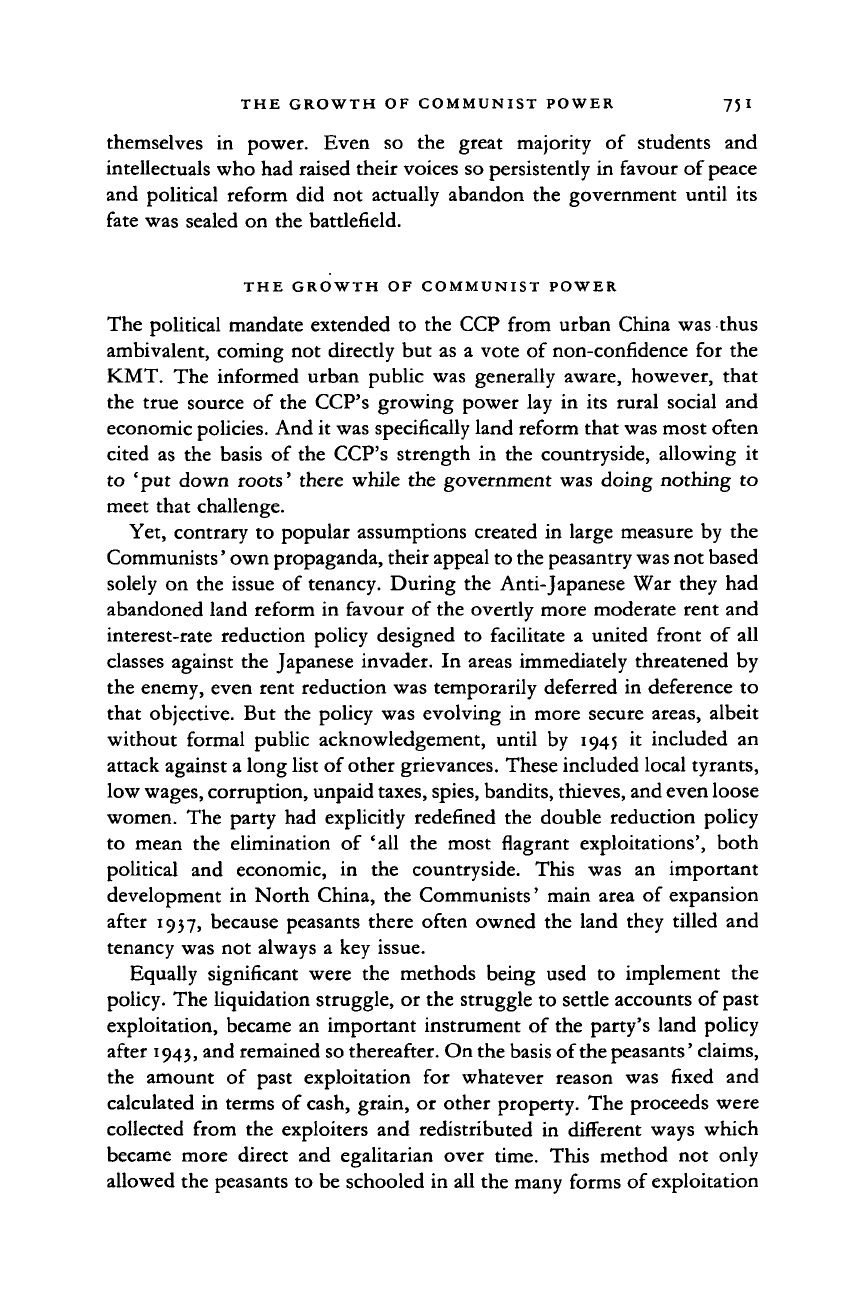
THE GROWTH OF COMMUNIST POWER 75 I
themselves in power. Even so the great majority of students and
intellectuals who had raised their voices so persistently in favour of peace
and political reform did not actually abandon the government until its
fate was sealed on the battlefield.
THE GROWTH OF COMMUNIST POWER
The political mandate extended to the CCP from urban China was thus
ambivalent, coming not directly but as a vote of non-confidence for the
KMT. The informed urban public was generally aware, however, that
the true source of the CCP's growing power lay in its rural social and
economic policies. And it was specifically land reform that was most often
cited as the basis of the CCP's strength in the countryside, allowing it
to 'put down roots' there while the government was doing nothing to
meet that challenge.
Yet, contrary to popular assumptions created in large measure by the
Communists' own propaganda, their appeal to the peasantry was not based
solely on the issue of tenancy. During the Anti-Japanese War they had
abandoned land reform in favour of the overtly more moderate rent and
interest-rate reduction policy designed to facilitate a united front of all
classes against the Japanese invader. In areas immediately threatened by
the enemy, even rent reduction was temporarily deferred in deference to
that objective. But the policy was evolving in more secure areas, albeit
without formal public acknowledgement, until by 1945 it included an
attack against a long list of other grievances. These included local tyrants,
low wages, corruption, unpaid taxes, spies, bandits, thieves, and even loose
women. The party had explicitly redefined the double reduction policy
to mean the elimination of 'all the most flagrant exploitations', both
political and economic, in the countryside. This was an important
development in North China, the Communists' main area of expansion
after 1937, because peasants there often owned the land they tilled and
tenancy was not always a key issue.
Equally significant were the methods being used to implement the
policy. The liquidation struggle, or the struggle to settle accounts of past
exploitation, became an important instrument of the party's land policy
after
1943,
and remained so thereafter. On the basis of the peasants' claims,
the amount of past exploitation for whatever reason was fixed and
calculated in terms of cash, grain, or other property. The proceeds were
collected from the exploiters and redistributed in different ways which
became more direct and egalitarian over time. This method not only
allowed the peasants to be schooled in all the many forms of exploitation
Cambridge Histories Online © Cambridge University Press, 2008
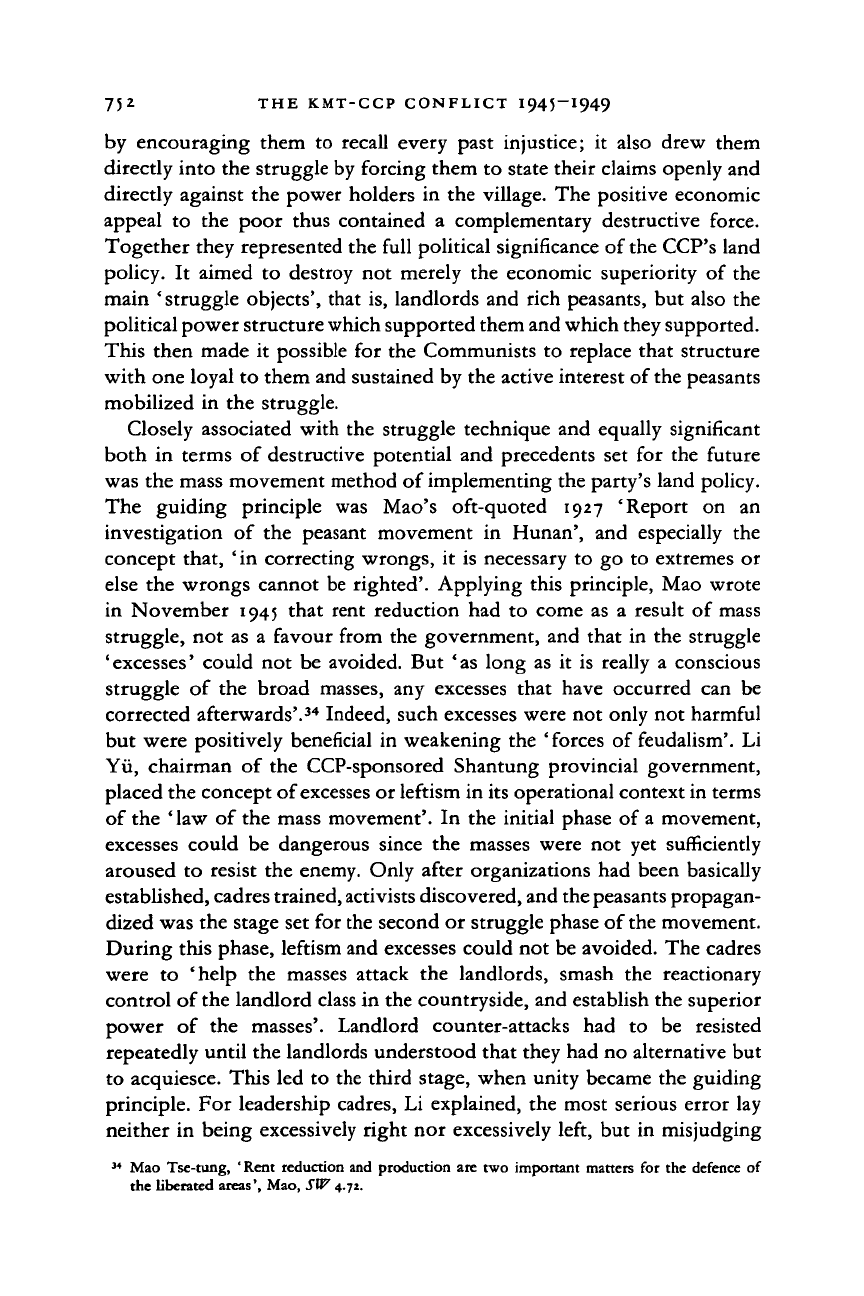
75
2
THE KMT-CCP CONFLICT 1945-I949
by encouraging them
to
recall every past injustice;
it
also drew them
directly into the struggle by forcing them
to
state their claims openly and
directly against
the
power holders
in the
village.
The
positive economic
appeal
to the
poor thus contained
a
complementary destructive force.
Together they represented the full political significance
of
the CCP's land
policy.
It
aimed
to
destroy
not
merely
the
economic superiority
of the
main 'struggle objects', that
is,
landlords
and
rich peasants,
but
also
the
political power structure which supported them and which they supported.
This then made
it
possible
for the
Communists
to
replace that structure
with one loyal
to
them and sustained
by
the active interest
of
the peasants
mobilized
in the
struggle.
Closely associated with
the
struggle technique
and
equally significant
both
in
terms
of
destructive potential
and
precedents
set for the
future
was
the
mass movement method
of
implementing the party's land policy.
The guiding principle
was
Mao's oft-quoted
1927
'Report
on an
investigation
of the
peasant movement
in
Hunan',
and
especially
the
concept that, ' in correcting wrongs,
it is
necessary
to go to
extremes
or
else
the
wrongs cannot
be
righted'. Applying this principle, Mao wrote
in November
1945
that rent reduction
had to
come
as a
result
of
mass
struggle,
not as a
favour from
the
government,
and
that
in the
struggle
'excesses' could
not be
avoided.
But 'as
long
as it is
really
a
conscious
struggle
of the
broad masses,
any
excesses that have occurred
can be
corrected afterwards'.
34
Indeed, such excesses were
not
only
not
harmful
but were positively beneficial
in
weakening
the
'forces
of
feudalism'.
Li
Yii,
chairman
of the
CCP-sponsored Shantung provincial government,
placed the concept of excesses
or
leftism in its operational context in terms
of the
'law of
the mass movement'.
In the
initial phase
of
a movement,
excesses could
be
dangerous since
the
masses were
not yet
sufficiently
aroused
to
resist
the
enemy. Only after organizations
had
been basically
established, cadres trained, activists discovered, and
the
peasants propagan-
dized was the stage set
for
the second
or
struggle phase
of
the movement.
During this phase, leftism and excesses could
not be
avoided. The cadres
were
to
'help
the
masses attack
the
landlords, smash
the
reactionary
control
of
the landlord class
in
the countryside, and establish the superior
power
of the
masses'. Landlord counter-attacks
had to be
resisted
repeatedly until the landlords understood that they had
no
alternative
but
to acquiesce. This
led to
the third stage, when unity became
the
guiding
principle.
For
leadership cadres,
Li
explained,
the
most serious error
lay
neither
in
being excessively right
nor
excessively left,
but in
misjudging
M
Mao
Tse-tung, 'Rent reduction and production
are two
important matters
for the
defence
of
the liberated areas', Mao,
SW
4.72.
Cambridge Histories Online © Cambridge University Press, 2008

THE GROWTH OF COMMUNIST POWER 753
the point at which the limits of one phase had been reached and the next
should begin within the context of the developing mass movement.
35
The party had discovered not only the issues that aroused the peasantry
but also how to harness the destructive energies of the spontaneous
peasant violence that regularly rose and fell in response to local grievances
but with little lasting result.
The land policy and the class friction it generated could become the
' mother of all other work' in a village, however, only after certain military
and political preconditions had been met in the area as a whole. The basic
prerequisite, established during the Japanese war, for the successful
implementation of rent reduction was the capacity to protect it against
its enemies both military and political. The anti-Japanese resistance
mobilized the manpower and the CCP provided the leadership necessary
to establish those preconditions all across North China as the strength
of the Japanese began to recede in 1943. Such military and political
security on so large a scale was a condition the Chinese Communist
movement had never enjoyed prior to the 1940s, and it grew directly out
of the Communists' successful effort to build a resistance movement
against the Japanese.
After 1945, the party's land policy could then become the key to the
CCP's relationship with the ' basic masses' of North China and that policy
was founded on a direct appeal to the poor and landless. In addition to
the material incentives provided by the distribution of
the'
struggle fruits',
the Communists could also offer a solution for what the peasantry as a
whole apparently perceived as its most immediate grievance: the corrupt
and arbitrary use of political power and social position within the village
community. In exploiting these issues - together with all the others
associated with the ownership and use of land, unpaid labour and
indebtedness - the CCP had found the formula for transforming the
military-political movement it had mobilized to resist the Japanese into
one that could build a new indigenous power structure, sustained by
popular participation and support once the Japanese were defeated.
36
The May Fourth Directive of 1946, which formally marked the shift
from the reduction of rents and interest rates back to land reform, did not
therefore represent that sharp a distinction between the two policies. The
directive in fact only acknowledged a development that had been in
process within the Communists' liberated areas for several years. In
accordance with that development, the directive authorized several
35
Li Yu, him
cb'm-cbung lu-bsimju Sban-tung cb'un-cbtmgjtm-tung (On
the
mass line and
the
mass
movement
in
Shantung).
36
Suzanne Pepper, Civil
War
in China: the political struggle, 1)41-194),
Cambridge Histories Online © Cambridge University Press, 2008
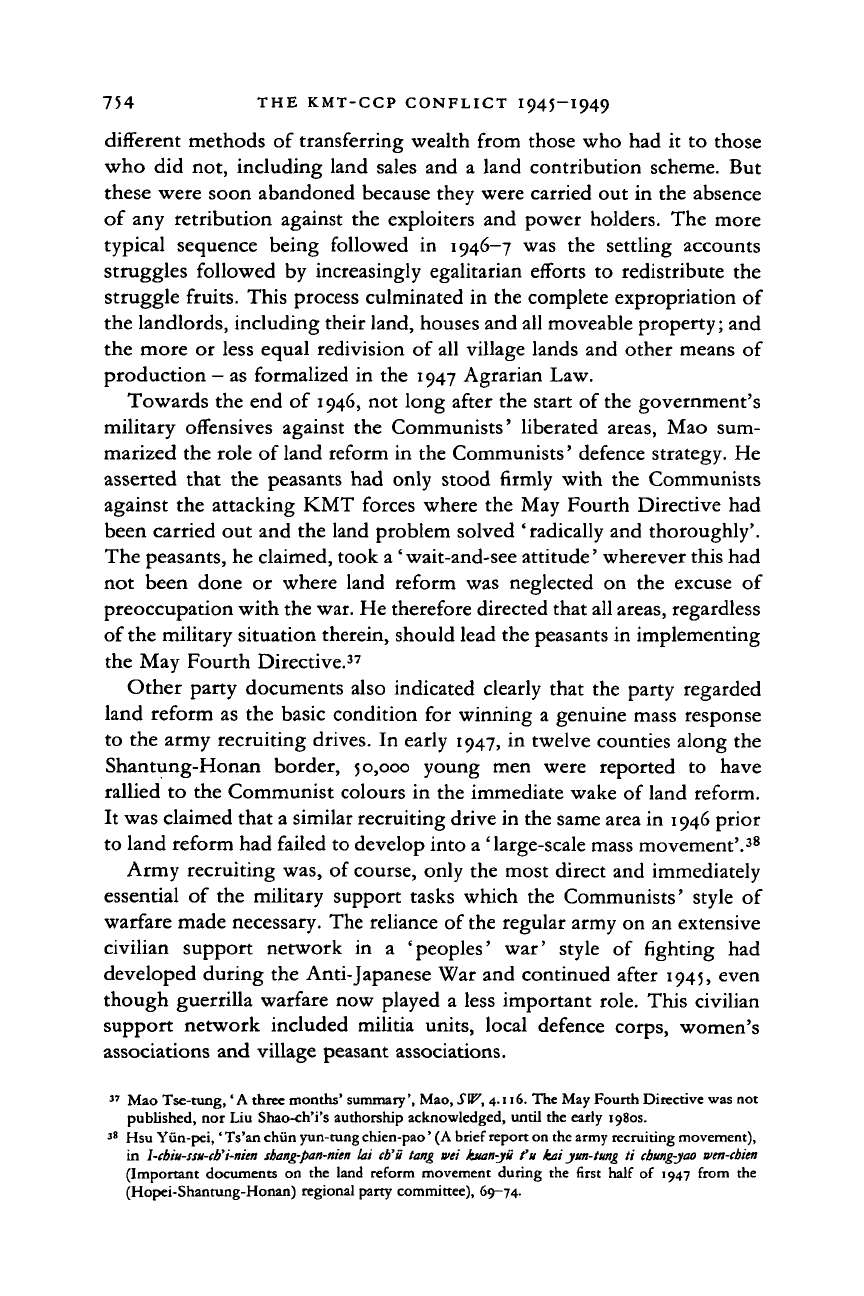
754 THE KMT-CCP CONFLICT 1945-1949
different methods of transferring wealth from those who had
it
to those
who did not, including land sales and
a
land contribution scheme. But
these were soon abandoned because they were carried out in the absence
of any retribution against the exploiters and power holders. The more
typical sequence being followed
in
1946—7 was
the
settling accounts
struggles followed by increasingly egalitarian efforts
to
redistribute the
struggle fruits. This process culminated in the complete expropriation of
the landlords, including their land, houses and all moveable property; and
the more or less equal redivision of all village lands and other means of
production
—
as formalized in the 1947 Agrarian Law.
Towards the end
of
1946, not long after the start of the government's
military offensives against the Communists' liberated areas, Mao sum-
marized the role of land reform in the Communists' defence strategy. He
asserted that the peasants had only stood firmly with the Communists
against the attacking KMT forces where the May Fourth Directive had
been carried out and the land problem solved 'radically and thoroughly'.
The peasants, he claimed, took a
'
wait-and-see attitude' wherever this had
not been done
or
where land reform was neglected
on
the excuse
of
preoccupation with the war. He therefore directed that all areas, regardless
of the military situation therein, should lead the peasants in implementing
the May Fourth Directive.
37
Other party documents also indicated clearly that the party regarded
land reform as the basic condition for winning
a
genuine mass response
to the army recruiting drives. In early 1947, in twelve counties along the
Shantung-Honan border, 50,000 young men were reported
to
have
rallied to the Communist colours in the immediate wake of land reform.
It was claimed that a similar recruiting drive in the same area in 1946 prior
to land reform had failed to develop into a 'large-scale mass movement'.
38
Army recruiting was, of course, only the most direct and immediately
essential
of
the military support tasks which the Communists' style
of
warfare made necessary. The reliance of the regular army on an extensive
civilian support network
in a
'peoples' war' style
of
fighting
had
developed during the Anti-Japanese War and continued after 1945, even
though guerrilla warfare now played
a
less important role. This civilian
support network included militia units, local defence corps, women's
associations and village peasant associations.
37
Mao Tse-tung,
'A
three months' summary', Mao,
SW,
4.116. The May Fourth Directive was not
published, nor Liu Shao-ch'i's authorship acknowledged, until the early 1980s.
38
Hsu Yun-pei,' Ts'an chun yun-tung chien-pao' (A brief report on the army recruiting movement),
in I-Mu-ssu-cb'i-nien sbang-pan-nien
lai
cb'ii tang met kuan-yii
fit
kni yun-tung
ti
cbung-jao wm-cbien
(Important documents
on
the land reform movement during the first half
of
1947 from the
(Hopei-Shantung-Honan) regional party committee), 69-74.
Cambridge Histories Online © Cambridge University Press, 2008
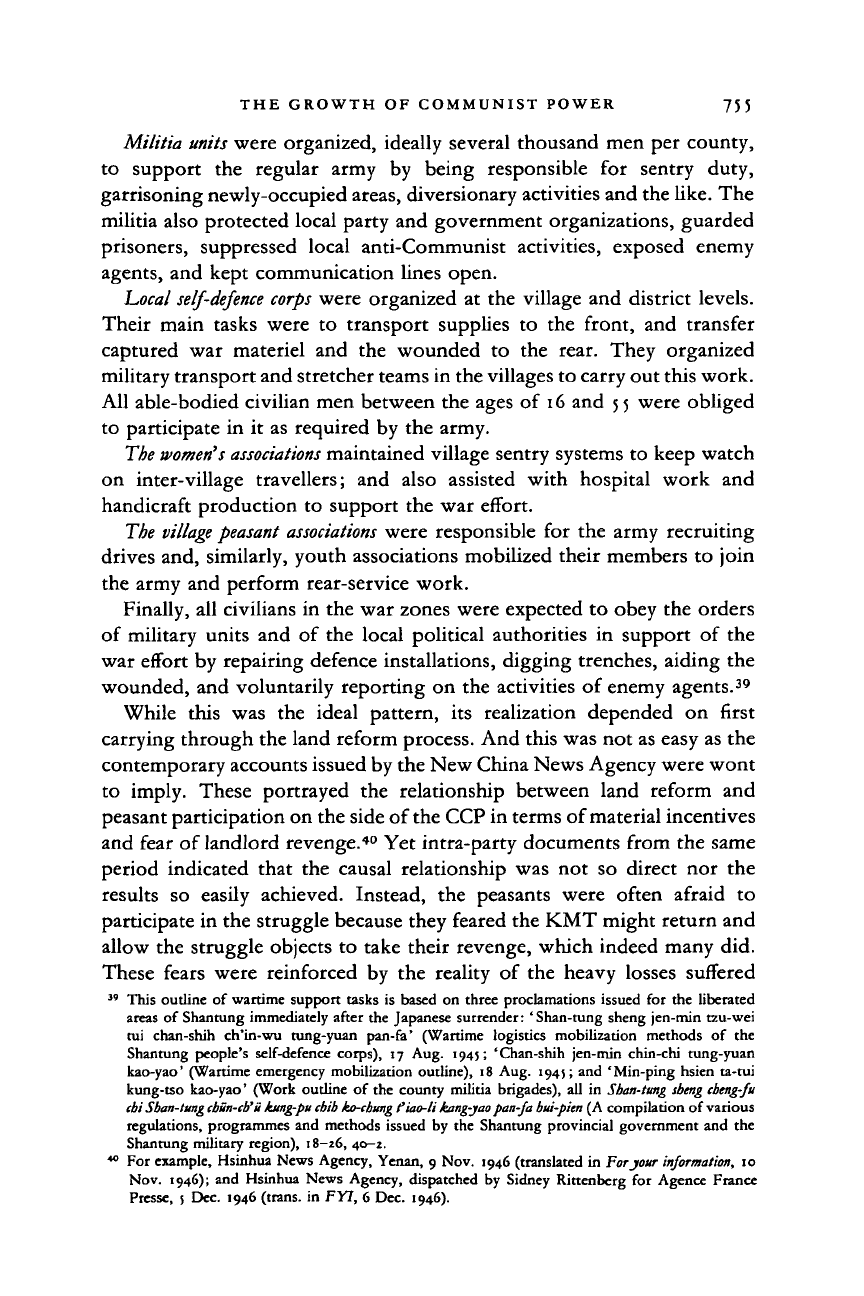
THE GROWTH OF COMMUNIST POWER 75 J
Militia
units
were organized, ideally several thousand men per county,
to support the regular army by being responsible for sentry duty,
garrisoning newly-occupied areas, diversionary activities and the like. The
militia also protected local party and government organizations, guarded
prisoners, suppressed local anti-Communist activities, exposed enemy
agents, and kept communication lines open.
Local self-defence corps
were organized at the village and district levels.
Their main tasks were to transport supplies to the front, and transfer
captured war materiel and the wounded to the rear. They organized
military transport and stretcher teams in the villages to carry out this work.
All able-bodied civilian men between the ages of 16 and 55 were obliged
to participate in it as required by the army.
The women's associations
maintained village sentry systems to keep watch
on inter-village travellers; and also assisted with hospital work and
handicraft production to support the war effort.
The
village peasant associations
were responsible for the army recruiting
drives and, similarly, youth associations mobilized their members to join
the army and perform rear-service work.
Finally, all civilians in the war zones were expected to obey the orders
of military units and of the local political authorities in support of the
war effort by repairing defence installations, digging trenches, aiding the
wounded, and voluntarily reporting on the activities of enemy agents.
39
While this was the ideal pattern, its realization depended on first
carrying through the land reform process. And this was not as easy as the
contemporary accounts issued by the New China News Agency were wont
to imply. These portrayed the relationship between land reform and
peasant participation on the side of the CCP in terms of material incentives
and fear of landlord revenge.
40
Yet intra-party documents from the same
period indicated that the causal relationship was not so direct nor the
results so easily achieved. Instead, the peasants were often afraid to
participate in the struggle because they feared the KMT might return and
allow the struggle objects to take their revenge, which indeed many did.
These fears were reinforced by the reality of the heavy losses suffered
39
This outline of wartime support tasks is based on three proclamations issued for the liberated
areas of Shantung immediately after the Japanese surrender: 'Shan-tung sheng jen-min tzu-wei
tui chan-shih ch'in-wu tung-yuan pan-fa' (Wartime logistics mobilization methods of the
Shantung people's self-defence corps), 17 Aug. 1945; 'Chan-shih jen-min chin-chi tung-yuan
kao-yao' (Wartime emergency mobilization outline), 18 Aug. 1945; and 'Min-ping hsien ta-tui
kung-tso kao-yao' (Work outline of the county militia brigades), all in
Sban-tung sbeng cbeng-fu
cbi Sban-tung cbun-ctfu kung-pu cbib ko-cbung fiao-li kang-jao pan-fa bui-pien (A compilation of various
regulations, programmes and methods issued by the Shantung provincial government and the
Shantung military region), 18-26, 40-2.
w
For example, Hsinhua News Agency, Yenan, 9 Nov. 1946 (translated in For jour
information,
10
Nov. 1946); and Hsinhua News Agency, dispatched by Sidney Rittenberg for Agence France
Presse, 5 Dec. 1946 (trans, in FYI, 6 Dec. 1946).
Cambridge Histories Online © Cambridge University Press, 2008
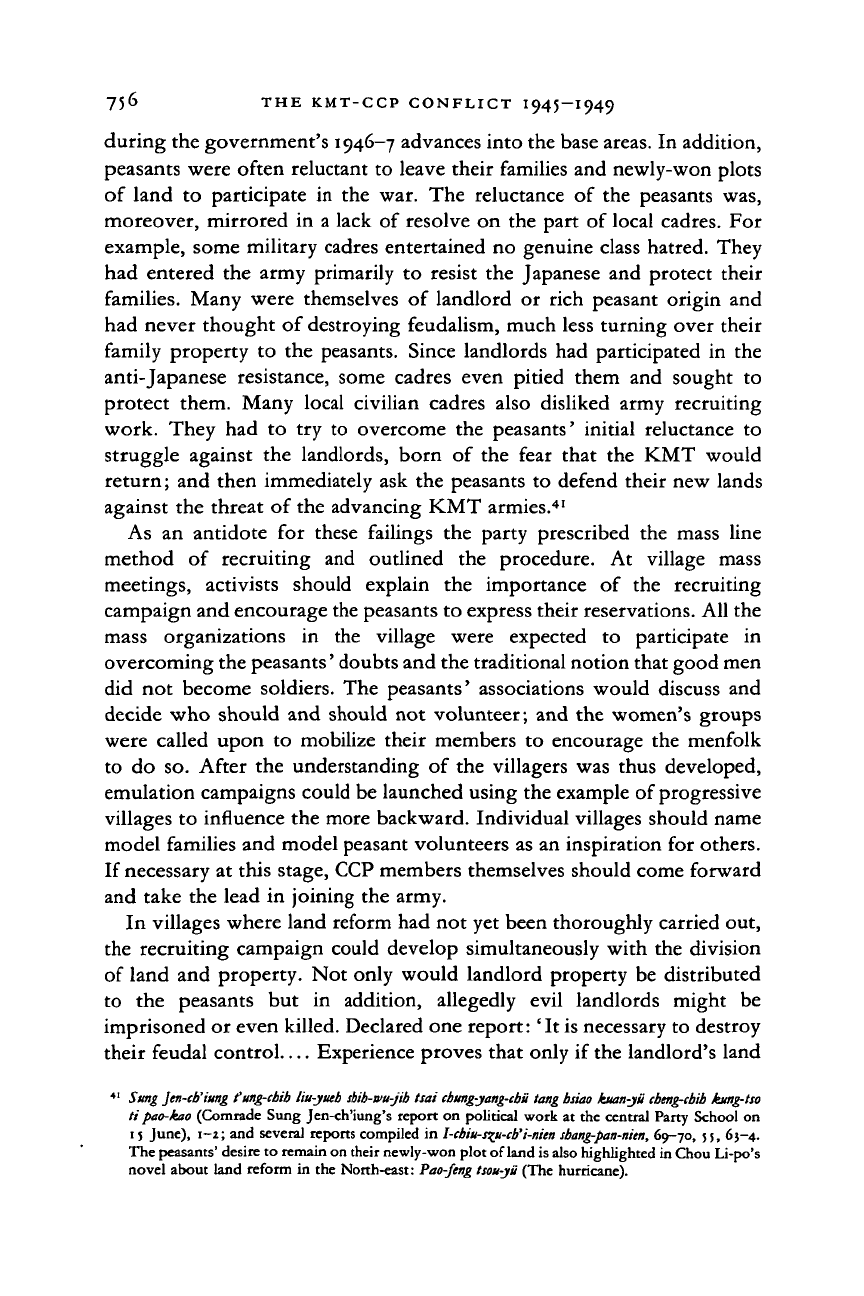
THE KMT-CCP CONFLICT 1945-1949
during the government's 1946-7 advances into the base areas. In addition,
peasants were often reluctant to leave their families and newly-won plots
of land
to
participate
in
the war. The reluctance
of
the peasants was,
moreover, mirrored in a lack of resolve on the part of local cadres. For
example, some military cadres entertained no genuine class hatred. They
had entered the army primarily
to
resist the Japanese and protect their
families. Many were themselves
of
landlord
or
rich peasant origin and
had never thought of destroying feudalism, much less turning over their
family property
to
the peasants. Since landlords had participated
in
the
anti-Japanese resistance, some cadres even pitied them and sought
to
protect them. Many local civilian cadres also disliked army recruiting
work. They had
to
try
to
overcome the peasants' initial reluctance
to
struggle against the landlords, born
of
the fear that the KMT would
return; and then immediately ask the peasants to defend their new lands
against the threat of the advancing KMT armies.
41
As
an
antidote
for
these failings the party prescribed the mass line
method
of
recruiting
and
outlined
the
procedure.
At
village mass
meetings, activists should explain
the
importance
of the
recruiting
campaign and encourage the peasants to express their reservations. All the
mass organizations
in the
village were expected
to
participate
in
overcoming the peasants' doubts and the traditional notion that good men
did not become soldiers. The peasants' associations would discuss and
decide who should and should not volunteer; and the women's groups
were called upon
to
mobilize their members
to
encourage the menfolk
to do so. After the understanding
of
the villagers was thus developed,
emulation campaigns could be launched using the example of progressive
villages to influence the more backward. Individual villages should name
model families and model peasant volunteers as an inspiration for others.
If necessary at this stage, CCP members themselves should come forward
and take the lead in joining the army.
In villages where land reform had not yet been thoroughly carried out,
the recruiting campaign could develop simultaneously with the division
of land and property. Not only would landlord property be distributed
to
the
peasants
but in
addition, allegedly evil landlords might
be
imprisoned or even killed. Declared one report:' It is necessary to destroy
their feudal control Experience proves that only if the landlord's land
41
Sung Jen-cb'iung fung-cbib liu-yueb sbib-vu-jib tsai cbung-jang-cbu tang bsiao kuan-yu
cbeng-cbib
kung-tso
ti
pao-kao
(Comrade Sung Jen-ch'iung's report on political work at the central Party School on
15 June), 1-2; and several reports compiled in
1-cbiu-s^u-cb'i-nien
sbang-pan-nien,
69-70, 55, 63—4.
The peasants' desire to remain on their newly-won plot of land is also highlighted in Chou Li-po's
novel about land reform in the North-east:
Pao-fetig tsou-ju
(The hurricane).
Cambridge Histories Online © Cambridge University Press, 2008
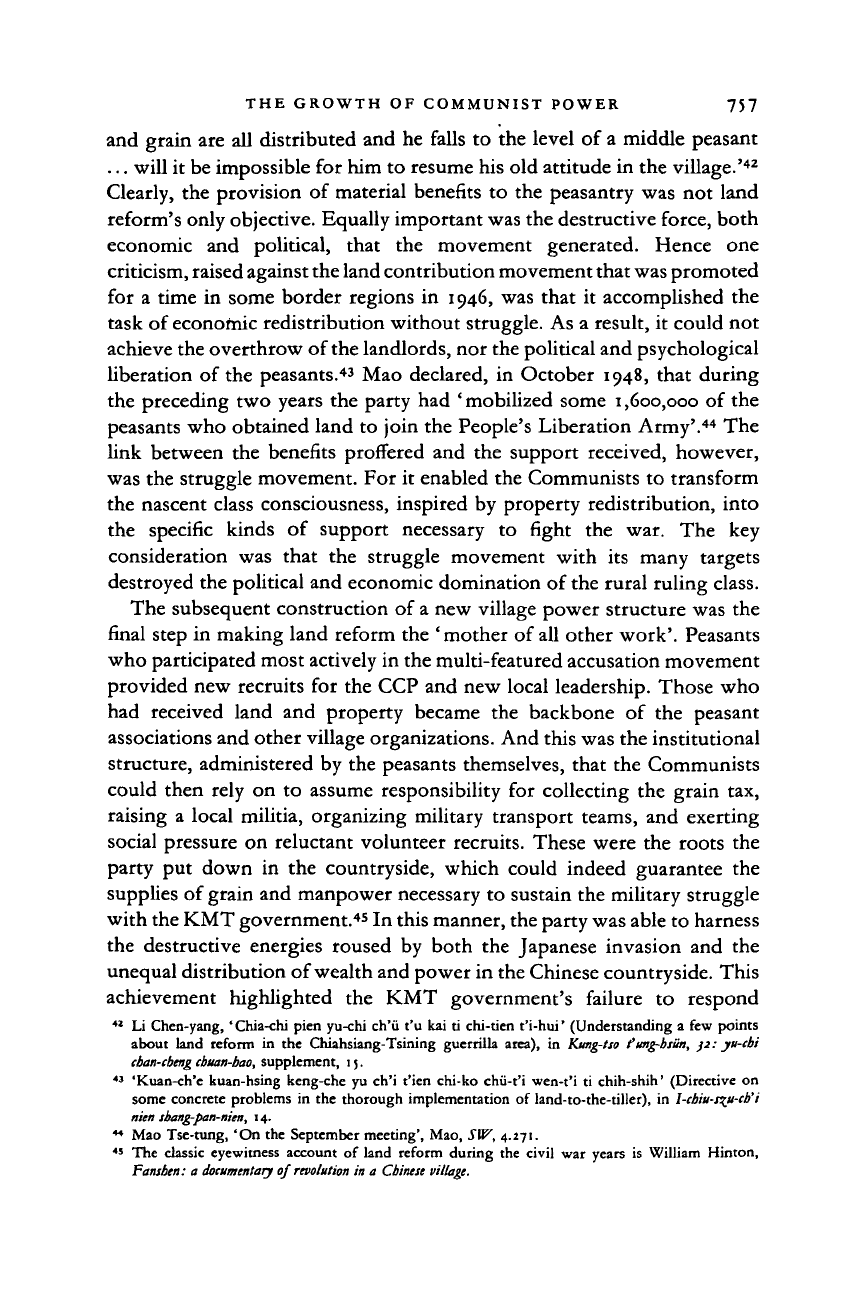
THE GROWTH OF COMMUNIST POWER 757
and grain are all distributed and he falls
to
the level of a middle peasant
... will it be impossible for him to resume his old attitude in the village.'
42
Clearly, the provision
of
material benefits
to
the peasantry was not land
reform's only objective. Equally important was the destructive force, both
economic
and
political, that
the
movement generated. Hence
one
criticism, raised against the land contribution movement that
was
promoted
for
a
time
in
some border regions
in
1946, was that
it
accomplished the
task of economic redistribution without struggle. As a result,
it
could not
achieve the overthrow of the landlords, nor the political and psychological
liberation
of
the peasants.
43
Mao declared,
in
October 1948, that during
the preceding two years the party had ' mobilized some
1,600,000
of
the
peasants who obtained land to join the People's Liberation Army'.
44
The
link between the benefits proffered and the support received, however,
was the struggle movement. For it enabled the Communists to transform
the nascent class consciousness, inspired by property redistribution, into
the specific kinds
of
support necessary
to
fight
the war. The key
consideration
was
that
the
struggle movement with
its
many targets
destroyed the political and economic domination of the rural ruling class.
The subsequent construction of a new village power structure was the
final step in making land reform the 'mother of all other work'. Peasants
who participated most actively in the multi-featured accusation movement
provided new recruits for the CCP and new local leadership. Those who
had received land
and
property became
the
backbone
of
the peasant
associations and other village organizations. And this was the institutional
structure, administered by the peasants themselves, that the Communists
could then rely
on to
assume responsibility
for
collecting the grain tax,
raising
a
local militia, organizing military transport teams, and exerting
social pressure on reluctant volunteer recruits. These were the roots the
party
put
down
in the
countryside, which could indeed guarantee
the
supplies of grain and manpower necessary to sustain the military struggle
with the KMT government.
45
In this manner, the party was able to harness
the destructive energies roused
by
both
the
Japanese invasion and
the
unequal distribution of wealth and power in the Chinese countryside. This
achievement highlighted
the
KMT government's failure
to
respond
4
* Li Chen-yang, 'Chia-chi pien yu-chi ch'ii
t'u
kai
ti
chi-tien t'i-hui' (Understanding
a
few points
about land reform
in the
Chiahsiang-Tsining guerrilla area),
in
Kimg-tso
fung-bsiin,
)2: ju-cbi
cban-cbeng cbuan-bao, supplement,
i;.
43
'Kuan-ch'e kuan-hsing keng-che
yu ch'i
t'ien chi-ko chii-t'i wen-t'i
ti
chih-shih' (Directive
on
some concrete problems
in the
thorough implementation
of
land-to-the-tiller),
in
I-cbiu-j^u-cb'i
men sbang-pan-nien,
14.
44
Mao Tse-tung,
'On the
September meeting', Mao,
SW,
4.271.
45
The
classic eyewitness account
of
land reform during
the
civil
war
years
is
William Hinton,
Fansben:
a
documentary
of
revolution
in a
Chinese village.
Cambridge Histories Online © Cambridge University Press, 2008
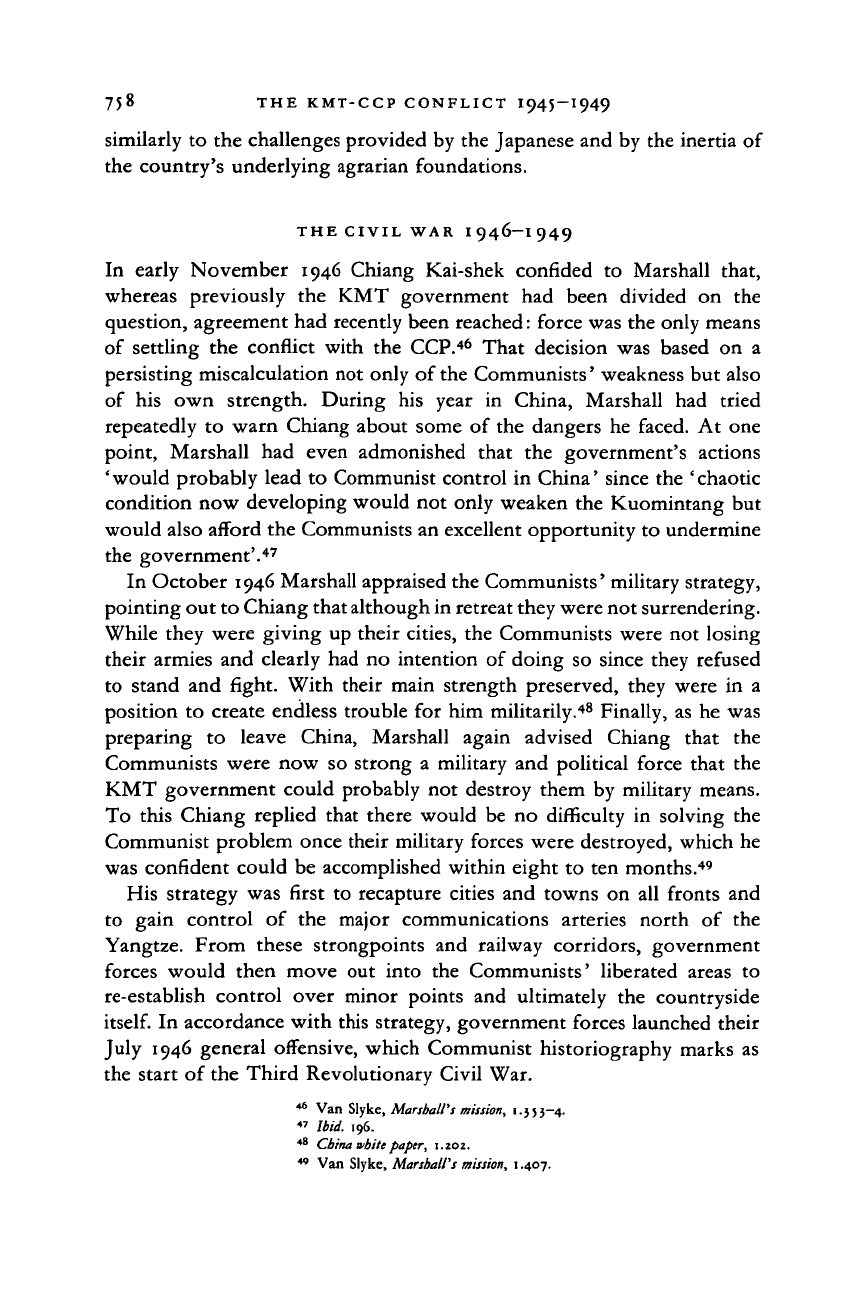
75 8 THE KMT-CCP CONFLICT I945-1949
similarly to the challenges provided by the Japanese and by the inertia of
the country's underlying agrarian foundations.
THE CIVIL WAR I 946—I 949
In early November 1946 Chiang Kai-shek confided to Marshall that,
whereas previously the KMT government had been divided on the
question, agreement had recently been reached: force was the only means
of settling the conflict with the CCP.
46
That decision was based on a
persisting miscalculation not only of the Communists' weakness but also
of his own strength. During his year in China, Marshall had tried
repeatedly to warn Chiang about some of the dangers he faced. At one
point, Marshall had even admonished that the government's actions
'would probably lead to Communist control in China' since the 'chaotic
condition now developing would not only weaken the Kuomintang but
would also afford the Communists an excellent opportunity to undermine
the government'.
47
In October 1946 Marshall appraised the Communists' military strategy,
pointing out to Chiang that although in retreat they were not surrendering.
While they were giving up their cities, the Communists were not losing
their armies and clearly had no intention of doing so since they refused
to stand and fight. With their main strength preserved, they were in a
position to create endless trouble for him militarily.
48
Finally, as he was
preparing to leave China, Marshall again advised Chiang that the
Communists were now so strong a military and political force that the
KMT government could probably not destroy them by military means.
To this Chiang replied that there would be no difficulty in solving the
Communist problem once their military forces were destroyed, which he
was confident could be accomplished within eight to ten months.
49
His strategy was first to recapture cities and towns on all fronts and
to gain control of the major communications arteries north of the
Yangtze. From these strongpoints and railway corridors, government
forces would then move out into the Communists' liberated areas to
re-establish control over minor points and ultimately the countryside
itself.
In accordance with this strategy, government forces launched their
July 1946 general offensive, which Communist historiography marks as
the start of the Third Revolutionary Civil War.
46
Van Slyke, Marshall's mission, 1.353—4.
47
Ibid. 196.
48
China wbitt paper, 1.202.
49
Van Slyke, Marshall's mission, 1.407.
Cambridge Histories Online © Cambridge University Press, 2008
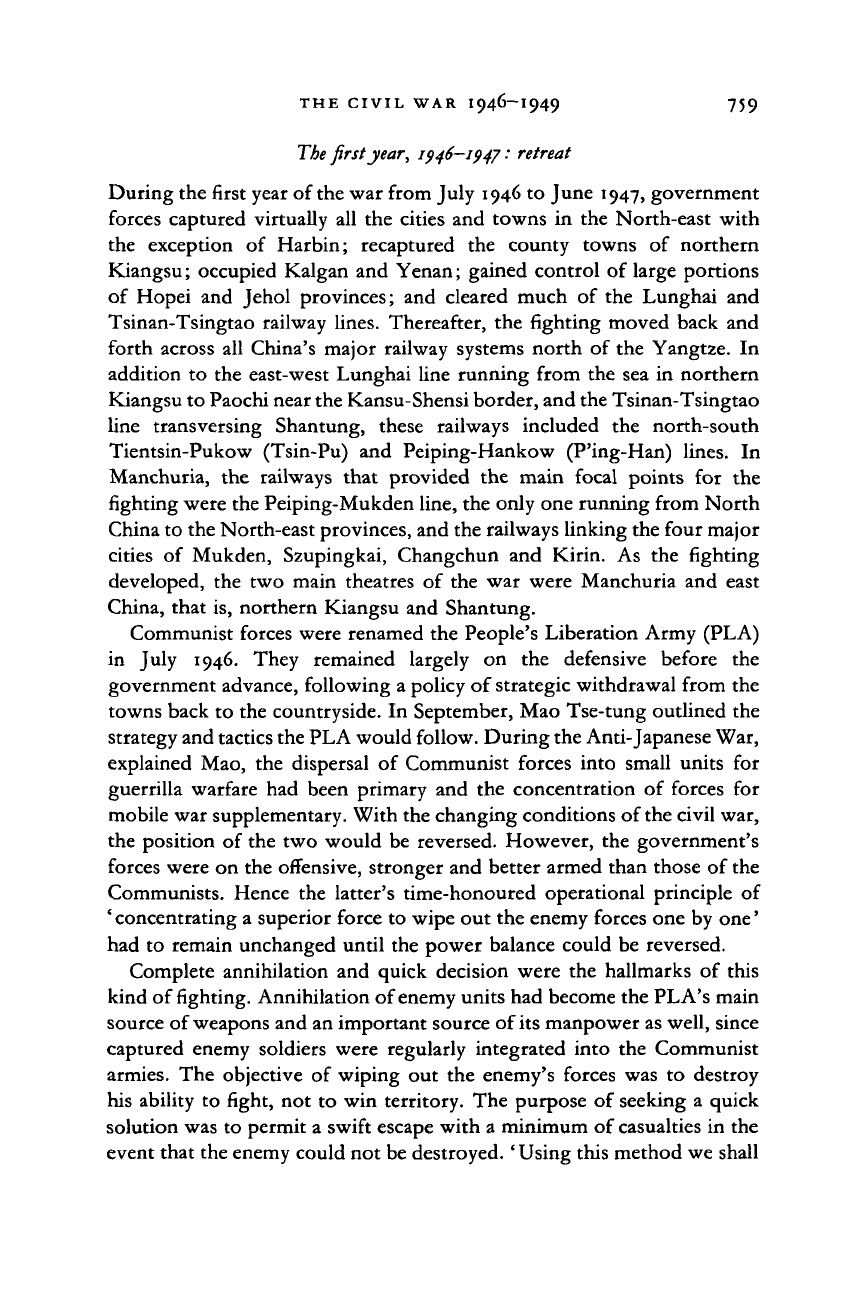
THE CIVIL WAR I946-I949 759
The first jear,
1946—1947:
retreat
During the first year of the war from July 1946 to June 1947, government
forces captured virtually all the cities and towns in the North-east with
the exception of Harbin; recaptured the county towns of northern
Kiangsu; occupied Kalgan and Yenan; gained control of large portions
of Hopei and Jehol provinces; and cleared much of the Lunghai and
Tsinan-Tsingtao railway lines. Thereafter, the fighting moved back and
forth across all China's major railway systems north of the Yangtze. In
addition to the east-west Lunghai line running from the sea in northern
Kiangsu to Paochi near the Kansu-Shensi border, and the Tsinan-Tsingtao
line transversing Shantung, these railways included the north-south
Tientsin-Pukow (Tsin-Pu) and Peiping-Hankow (P'ing-Han) lines. In
Manchuria, the railways that provided the main focal points for the
fighting were the Peiping-Mukden line, the only one running from North
China to the North-east provinces, and the railways linking the four major
cities of Mukden, Szupingkai, Changchun and Kirin. As the fighting
developed, the two main theatres of the war were Manchuria and east
China, that is, northern Kiangsu and Shantung.
Communist forces were renamed the People's Liberation Army (PLA)
in July 1946. They remained largely on the defensive before the
government advance, following a policy of strategic withdrawal from the
towns back to the countryside. In September, Mao Tse-tung outlined the
strategy and tactics the PLA would follow. During the Anti-Japanese War,
explained Mao, the dispersal of Communist forces into small units for
guerrilla warfare had been primary and the concentration of forces for
mobile war supplementary. With the changing conditions of
the
civil war,
the position of the two would be reversed. However, the government's
forces were on the offensive, stronger and better armed than those of the
Communists. Hence the latter's time-honoured operational principle of
' concentrating a superior force to wipe out the enemy forces one by one'
had to remain unchanged until the power balance could be reversed.
Complete annihilation and quick decision were the hallmarks of this
kind of fighting. Annihilation of enemy units had become the PLA's main
source of weapons and an important source of
its
manpower as well, since
captured enemy soldiers were regularly integrated into the Communist
armies. The objective of wiping out the enemy's forces was to destroy
his ability to fight, not to win territory. The purpose of seeking a quick
solution was to permit a swift escape with a minimum of casualties in the
event that the enemy could not be destroyed. ' Using this method we shall
Cambridge Histories Online © Cambridge University Press, 2008
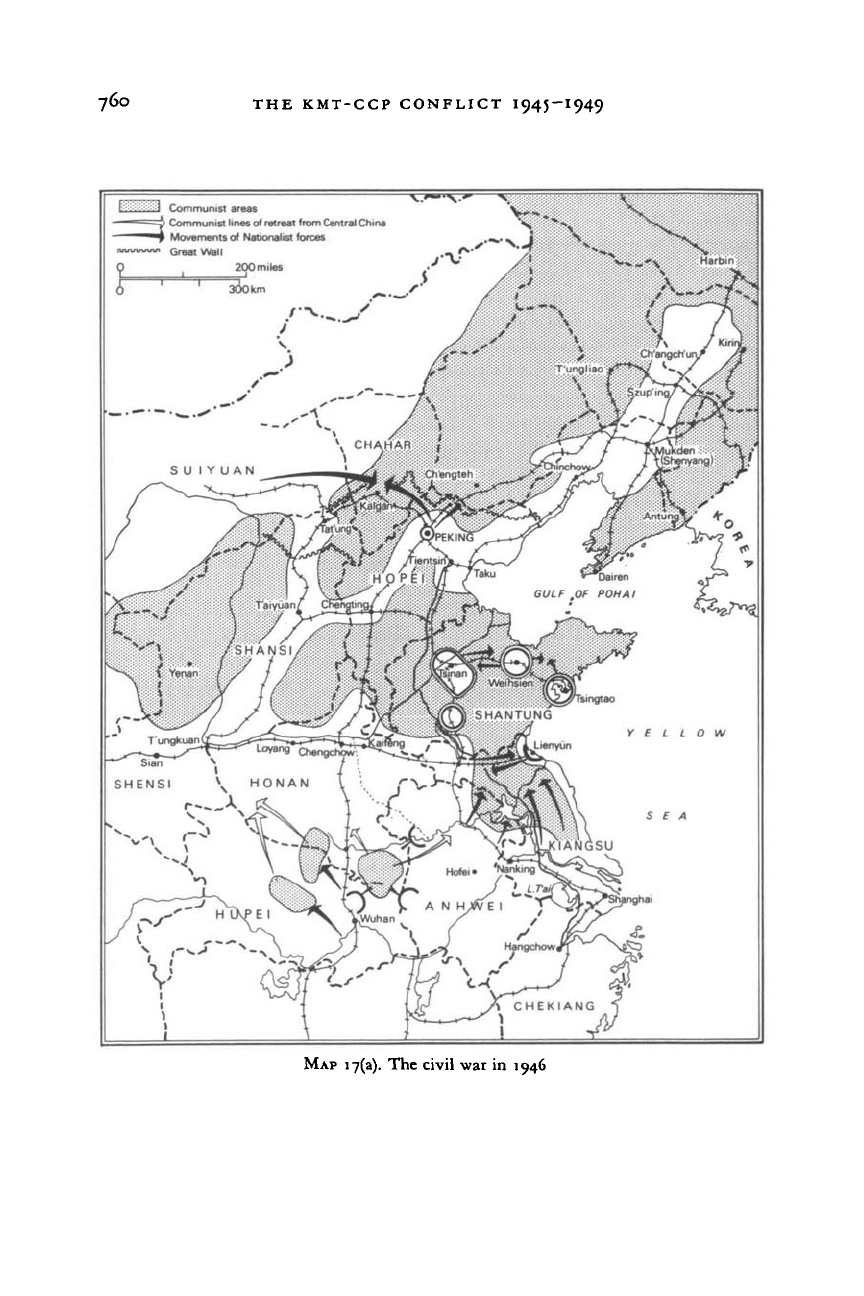
760
THE KMT-CCP CONFLICT I945-I949
Iffiii&l&l Communist areas
—£ Communist lines of retreat from Central China
IWI
~
UWU1
Great Wall
9
(
200
miles
A
' '
300km
•C
%
y
—- *
S U
1
Y UAN
'X^Z/
(
Ta,yuan/
r
v
'
\
7
/*
"*
**\ i /
-*
^
/•*-••*•
^-^
SHENSI \ HONAN
V
!
#
1
l^^/\
XT
1
IT—'\f
1
\
1
!
\
\
CH/
/
*
Cliengting/
H
if
A
{I
1
\
<
m
/
kHAR
j?pl
€
tfeng
/->
•^
••.
lip
an
/
k
\
A*
A
r
f\
t
i
Chengteh
©PEKINiS'
BntsinV^^^
\u5!i
Hofei*
AIIHj/
y
A
/'
y
\
T'ungliao Jf****^
\
y
raluJ
^^)airen
G(/tf
,Of
POHAI
^^^Tsingtao
SHANTUNG
vzSttK
u
y
j *$
^/TcHEKIANG
f
^\
Harbin
ft'
Ofangctfun/
/|'
E
L L 0
W
SEA
I
MAP
i7(a).
The
civil war
in 1946
Cambridge Histories Online © Cambridge University Press, 2008
